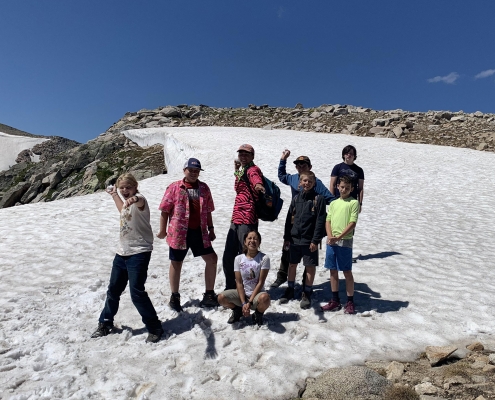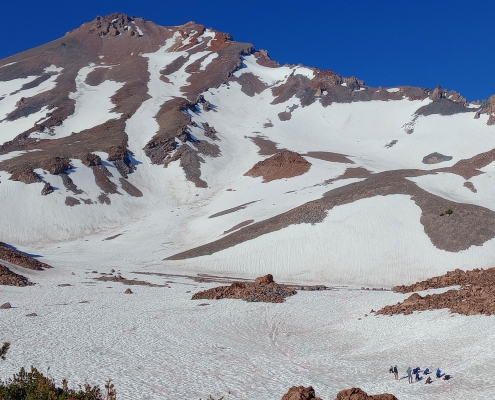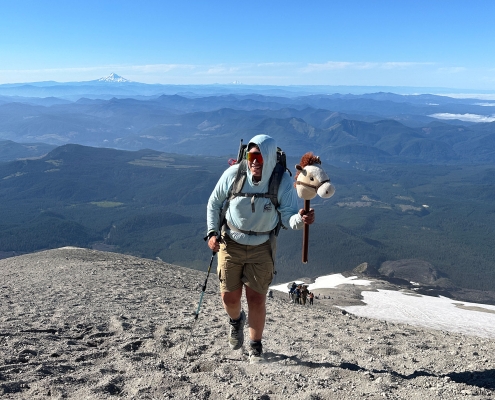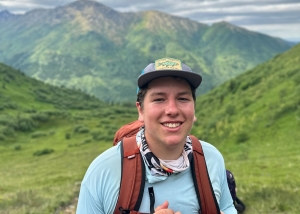Some lessons can only be learned the hard way: step by step on the side of a big mountain. In his college essay, five-year Adventure Treks student Finn reflects on how three summers of summit attempts taught him what real perseverance looks like. From turning around at 9,000 feet on Mount Shastina to finally standing on top of Mount St. Helens, Finn discovered that progress isn’t always about reaching the peak, but rather about determination, hard work, and expedition mentality. His college essay reflects how the mountains have taught him to adapt, persevere, and be proud of himself along the way.
By Finn S. from Greensboro, NC; student from 2022–2026 on Colorado Explorer, California Adventure, Ultimate Northwest, Alaska Expedition, Norway Expedition
As my boot planted in the sand and I looked up the mountain, all I saw was a wide open chute of straight ash and sediment. They call it the vertical beach. If you take two steps forward, you would slide back three. That was the last obstacle standing in the way of achieving my first summit. This would take three years of perseverance and determination to get to this point.
In freshman year, my best friend asked me to do a summer camp with him called Adventure Treks. The camp consisted of sleeping outside in a tent for 13 days straight, backpacking, climbing, and the main part, the summit. When I was preparing for the adventure, I thought that I was in good condition because of the fact that I was an athlete and participated in many sports. It wasn’t until I woke up at 4:00 am on the morning of my summit attempt, I felt worried about what was coming up. When I was halfway up Hallett Peak at roughly 9,000 feet above sea level, my stomach started turning over. I had a feeling I knew what was about to happen because I had gotten altitude sickness before, and it wasn’t a fun experience. At this moment, my goal was to not drag the group down and just continue to push myself to keep up with everyone. The plan had been to continue up, but others were struggling just as much as I was, and in the end, we decided the safest and most logical thing to do was to turn around and head down.
One thing that I learned on my time hiking up the mountain was “expedition mentality.” This means thinking for the group and what is best for everyone, not just myself.
The next year, I took a trip with hopes to tackle the mighty Mount Shastina. I was given all this equipment that I have never seen before: crampons, ice axes, and mountaineering boots. We didn’t need them until we got to base camp, but just getting there was going to be a challenge. I was about halfway up to base camp when I immediately felt nauseous (altitude sickness), worse than anything I have felt before. The goal quickly turned from summiting to making it to base camp. I was struggling up the hill, taking multiple-minute breaks every couple of minutes. When I made it to base camp, I was extremely proud of myself because I knew that I couldn’t continue on, but I achieved the goal I set for myself.
This helped me learn that being flexible is very important, and if something doesn’t go my way, I just have to adapt around it.
It wasn’t until last year that I had another shot at a summit attempt. This time it was Mount St. Helens, a lower-altitude mountain but still a very challenging one. This attempt called for a very early wake-up to start the hike. Once I got above the tree line, the top came into view. But the look was deceiving as it was still hours away. And then there it was, the vertical beach, a straight shoot of straight ash and sand—the most challenging factor yet, both mentally and physically. I pushed through and achieved the goal I made for myself three years before and stood at the summit of the mountain. This moment represented overcoming my previous failures of not summiting and reinforced the most important lesson that I have learned from my summit attempts: that if you try and try again, success will come.
Throughout my entire time working towards my first summit, I learned that being resilient and persistent helped me to achieve my goal.
I will look back to these experiences and think about how I set a goal for myself and worked hard and pushed myself to achieve it.
Finn’s perspective shows that the most rewarding moments in life come with hard work and perseverance. That determination to keep going, even when the trail turns steep or plans change, is what transforms challenge into confidence.
At Adventure Treks, we see that same transformation unfold every summer. When students learn to embrace setbacks and celebrate effort as much as they do achievement, they return home with a deeper belief in their own abilities—a mindset that lasts long beyond camp.





